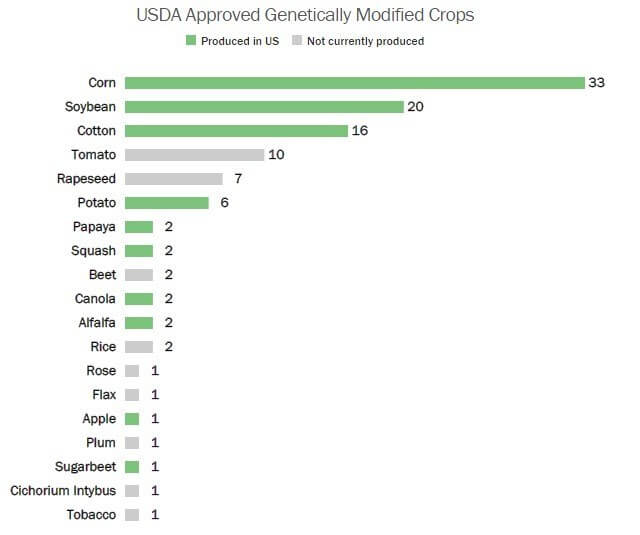时代周刊:供人直接食用的转基因作物知多少?
大家知道,目前世界上最广泛种植的转基因食品,是玉米和大豆。但根据《时代周刊》2015年的介绍,实际上作为粮食直接供人食用的只占很少的比例。
转基因玉米大多用于饲料,其次是玉米糖浆和玉米淀粉。超市里买的整根玉米棒子(corn on cob),则很少有转基因产品 http://www.ewg.org/enviroblog/2014/04/corn。2013年的一项调查,美国超市71例调查,只有2例是转基因玉米。
http://www.foe.org/news/news-releases/2013-11-new-study-gmo-sweet-corn-rare-in-us-supermarkets
"Only two corn samples out of 71 (2.4 percent) tested positive as genetically engineered. Both were confirmed to be Monsanto Seminis® Performance Series™ sweet corn."

1. Corn
Genetically modified corn turns up in many different products in the U.S. — and corn on the cob is the least of it. This crop is used to produce many different ingredients used in processed foods and drinks, including high-fructose corn syrup and corn starch. But the bulk of the GM corn grown around the world is used to feed livestock. Some is also converted into biofuels.
转基因大豆则多用于饲料和豆油。尽管在美国,家庭烹饪用豆油的很少,但在快餐店和各种零食的加工中却用量很大,以至于占到植物油总用量的60%。
2. Soybeans

The second largest U.S. crop after corn, GM soy is used primarily in animal feed and in soybean oil—which is widely used for processed foods and in restaurant chains. In fact, soybean oil accounts for 61% of Americans' vegetable-oil consumption. It's also often used to make an emulsifier called soy lecithin, which is present in a lot of processed foods, including dark chocolate bars and candy.
那么我们中国大量引进转基因大豆是否合理呢?我觉得还是要采取谨慎前行的态度。毕竟中国人的豆制品消费量比美国人大得多,而在美国转基因大豆主要是作辅助原料和饲料用的。
此外,个人觉得,美国转基因豆油的味道,跟我国东北豆油的味道,真的是相差悬殊,做菜完全没有后者的醇香。从一个吃货的角度,俺怎么也不能接受国内豆油全部变成转基因滴。俺家领导还发现,转基因的大豆发豆芽做豆腐的产率都远低于非转基因的大豆,从这点上说,转基因反而是个劣势。
再往下看,转基因土豆尽管存在,但尚未进入食品市场;转基因西红柿美国本土目前尚未种植。而转基因棉花,大家又不会吃进肚子里,就无所谓了。
以下英文版转自 http://time.com/3840073/gmo-food-charts/
These Charts Show Every Genetically Modified Food People Already Eat in the U.S.
Chipotle announced Monday that the chain will no longer serve food containing genetically modified organisms (GMO), raising the bar for transparency in the United States, where there's no requirement to indicate the presence of GMO ingredients on food labels or in restaurants. Likewise, biotechnology companies aren't required to report which genetically modified seeds are used in production.
Yet the use of GMOs is undoubtedly widespread. Since GMOs were approved for commercial use, and then first planted into U.S. soil in 1996, their production has increased dramatically. More than 90% of all soybean cotton and corn acreage in the U.S. is used to grow genetically engineered crops. Other popular and approved food crops include sugar beets, alfalfa, canola, papaya and summer squash. More recently, apples that don't brown and bruise-free potatoes were also approved by the FDA.
Adoption of GMO Crops in the US, 1996-2014
It's also instructive to look at permits granted by the United States Department of Agriculture (USDA) and the Food and Drug Administration (FDA) — the American GMO gatekeepers, together with the Environmental Protection Agency – though it's important to note that not all the issued permits are for crops that are approved for commercial use.
To produce crops commercially, biotech companies apply for "deregulated status", the green light from the USDA to plant and distribute without restriction.
The bar chart below shows all deregulated crops, sized by the number of genetic varieties approved for each. The ten crops in green are currently produced in the United States, and described in detail in the list below.

3. Cotton
Much of GM cotton is turned into cottonseed oil, which is used for frying in restaurants and in packaged foods like potato chips, oily spreads like margarine, even things like cans of smoked oysters. Some parts of the plant are also used in animal feed, and what's left over can be used to create food fillers such as cellulose.

5. Papaya
Bred to withstand ringspot virus, which can destroy papaya plants, these genetically engineered 'Rainbow Papayas' were first commercially produced in the late 1990s. Much of the yield is grown in Hawaii.
2 Genetically Modified Varieties

6. Squash
Zucchini and yellow summer squash have been commercially available in the U.S. since the mid- to late-'90s, though GM squash accounts for just 25,000 acres of farmland, by some estimates.
2 Genetically Modified Varieties

7. Canola
GM canola is used to make oil for cooking, as well as margarine. It's also used to produce emulsifiers that are used in packaged foods. By some estimates, 90% of canola grown in the U.S. and Canada is GM.
2 Genetically Modified Varieties

8. Alfalfa
In a controversial decision in 2011, the FDA approved the commercial use of GM alfalfa that contains a gene making it resistant to herbicide. The crop is used mainly as hay for cattle.
2 Genetically Modified Varieties

9. Apples
Another newly approved crop, this apple from a Canadian biotech company does not brown even after it's been sliced. It recently received FDA approval. The agency said it is safe to eat, which means they may appear on supermarket shelves.
1 Genetically Modified Variety

10. Sugar Beets
More than half the granulated sugar in the United States comes from GM sugar beets, which have been in production since 2008. Though their use was temporarily halted due to safety concerns, production resumed in 2011.
1 Genetically Modified Variety
Methodology
GM crops produced in the U.S. are listed at the International Service for the Acquisition of Agri-biotech. Deregulated crops are tracked at the USDA's Animal and Plant Health Inspection Service.

